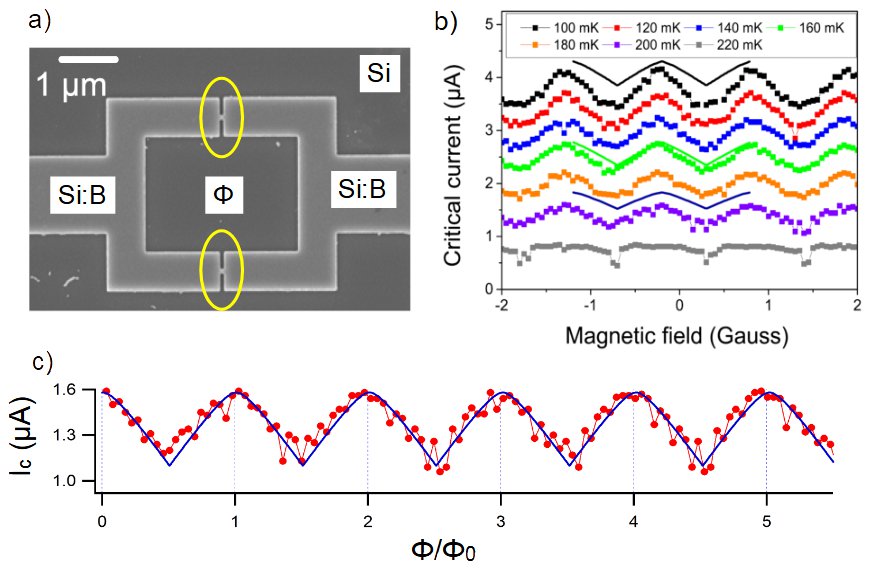Cryo-Electronics and Space Bolometry
Contact: Francesca Chiodi
Thanks to the extensive characterisation and global understanding of the structural and low temperature transport properties of ultra-doped Si:B, proof-of-concept quantum devices could be demonstrated in the last years. On one side, the realised devices allowed to investigate in more depth the physics of the superconducting boron-doped Si, especially at high frequency. On the other side, all silicon quantum devices represented a first step towards an integrated Si quantum electronics and ultra-sensitive astronomic detection of certain interest owing to silicon potential.
Three main superconducting silicon devices were realised in the group: i) the Superconducting Quantum Interference Device (SQUID), which allowed demonstrating the macroscopic nature of the quantum wave function of superconductivity in silicon, as opposite to a percolation-controlled transport; ii) the all-silicon Josephson junction, a first step towards the Josephson transistor, which, thanks to the extremely transparent epitaxial interface between superconducting Si:B (S) and doped Si (N), allowed demonstrating long phase coherence times and a full proximity effect in all silicon SNS junctions; iii) the superconducting silicon resonator, which highlighted the large Si:B kinetic inductance, and its strong non-linearity with power, proposing superconducting silicon as a choice material for large tunable inductors, sought after in quantum information.

SEM micrograph of a SQUID etched from a single Si:B layer: a superconducting Si loop (S) is interrupted by two constrictions of weaker Tc (S’) creating SS’S Dayem bridges. b) Critical current oscillations with magnetic field (creating a magnetic flux in the loop) for temperatures in the 100 mK – 220 mK range, and theoretical expectations from Ginzburg-Landau equations. [Duvauchelle2015] c) Critical current modulation at 200 mK, fitted with the model from [Balestro2003] for a symmetric SQUID, taking into account the inductance of the loop.

a,c) Typical resonance curve measurement (black dots) in a transmission-coupled geometry at T=14 mK and read-out power P=-125 dBm. The setup background transmission has been removed. b,d) A typical resonance curve measurement for shunt-coupled P=-143 dBm . Red dashed lines: modelled transmission coefficient. e) Scheme of the CPW section f) Sheet kinetic inductance Lk,□ as a function of Si:B depth inferred from measurements at DC (blue dots) or at RF (red triangles). The error bars attributed to the thickness are associated to the uncertainty of the thickness of the superconducting layer within the doped layer. g) Amplitude and phase of the transmission coefficient representing the resonance curves in the non-linear regime attained for increasing input power, corresponding to a number of photons in the resonator varying from 1 (black line) to 13000 (red line). Both up and down frequency sweeps are plotted, showing hysteretical behaviour at high power.
Publications
2022 • P. Bonnet, F. Chiodi, D. Flanigan, R. Delagrange, N. Brochu, D. Débarre, and H. le Sueur, Strongly non-linear superconducting silicon resonators - Phys. Rev. Applied 17, 034057
2017 • F. Chiodi, J. E. Duvauchelle, C. Marcenat, D. Débarre, and F. Lefloch, Proximity induced superconductivity in all-silicon superconductor-normal metal junctions – Phys. Rev. B 96, 024503
2015 • J. E. Duvauchelle, A. Francheteau, C. Marcenat, F. Chiodi, D. Débarre, K. Hasselbach, J. R. Kirtley, and F. Lefloch, Silicon superconducting quantum interference device - Appl. Phys. Lett. 107, 072601
2014 • F. Chiodi, A. D. Chepelianskii, C. Gardès, G. Hallais, D. Bouchier, and D. Débarre, Laser doping for ohmic contacts in n-type Ge – Appl. Phys. Lett. 105, 242101
• F. Chiodi, A. Grockowiak, J. E. Duvauchelle, F. Fossard, F. Lefloch, T. Klein, C. Marcenat, D. Débarre, Gas Immersion Laser Doping for superconducting nanodevices – Appl. Surf. Sci. 302, 209
2013 • A. Grockowiak T. Klein, H. Cercellier, F. Lévy-Bertrand, X. Blase, J. Kačmarčik, T. Kociniewski, F. Chiodi, D. Débarre, G. Prudon, C. Dubois, and C. Marcenat, Thickness dependence of the superconducting critical temperature in heavily doped SiB epilayers – Phys. Rev. B 88, 064508





